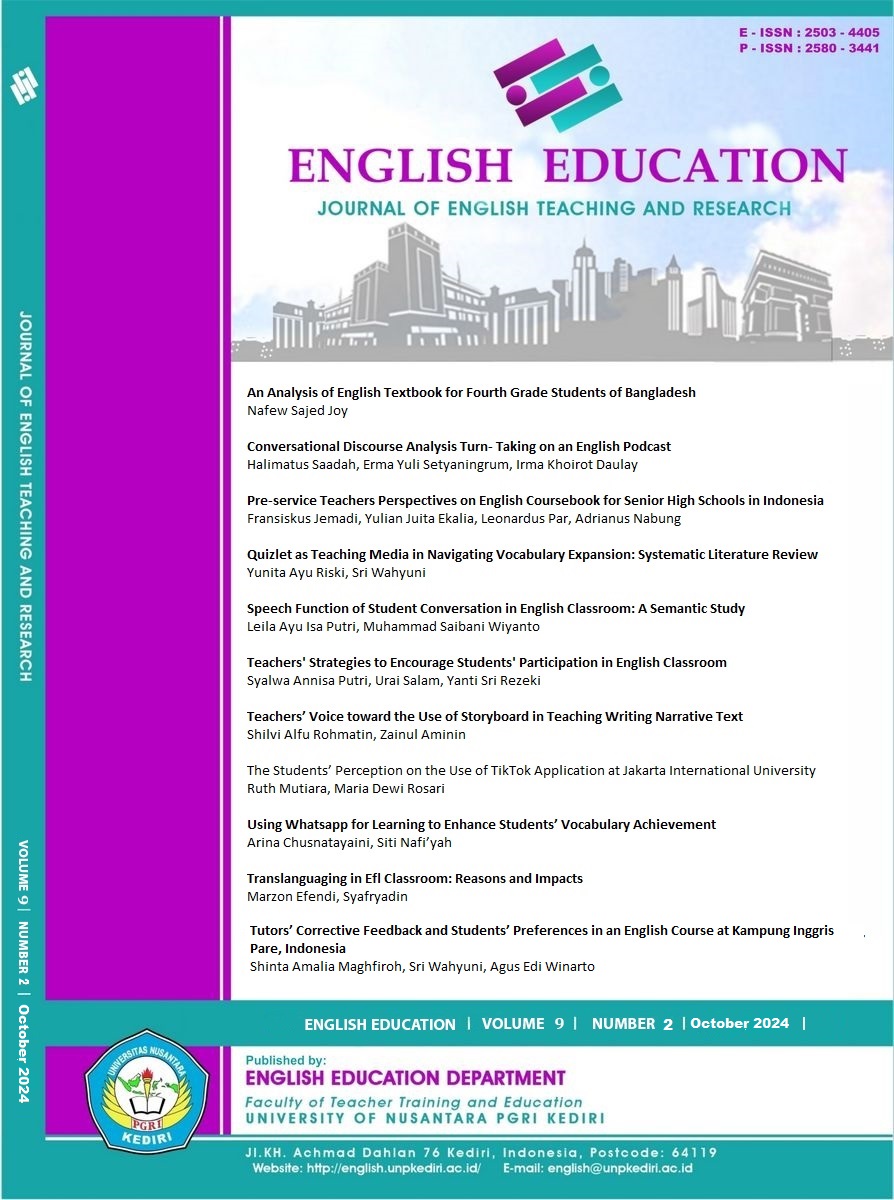Conversational Discourse Analysis Turn- Taking on an English Podcast
DOI:
https://doi.org/10.29407/jetar.v9i2.21896Keywords:
Communication process, turn taking strategyAbstract
The use of turn-taking strategy is crucial in understanding the dynamics of conversation. This study aims to find out the turn-taking strategy used and how it impacts the communication process in English podcast video. This research uses descriptive qualitative and the object of research is a video podcast with analysis using Stenstroom theory. The results showed that taking over strategy was used the most, followed by promoting and appealing strategy. Other strategies such as starting up, overlapping, filled pauses & verbal fillers, and repetition of words were also recorded with lower frequency of use. However, no use of interrupting, repair, and giving up strategies in the conversations were observed. Based on the results of this study, it indicates a preference for the smooth flow of conversation in the communication process.
Downloads
References
Aisyah, Siti. (2021). Conversation Analysis Of Turn Taking Mechanism In Ever After Movie. LANGUAGE HORIZON: Journal of Language Studies, 9(2). DOI: https://doi.org/10.26740/lh.v9n2.p61-68
Ashiqid, Yasa Ayatina & Sariyati, Ice. (2022). Turn-Taking Strategies of Conversation in Warren Edward Buffet Interview on Squawk Box Business News. BRIGHT Journal of English Language Teaching, Linguistics and Literature, 5(1).
Brown & Yule. (1983). Discourse Analysis. Cambridge University Press.
Ertanti, Devi & Ariyanti, Lisetyo. (2016). Turn Taking Strategies Used in Masterchef Junior Season 3 in America TV Show. Language Horizon, 4(3). DOI: https://doi.org/10.26740/lh.v4n3.p%25p
Fathimiyah, F. (2016). Turn-taking strategies used by Donald Trump’s interview in the University of Wisconsin-Green Bay (Doctoral dissertation, Universitas Islam Negeri Maulana Malik Ibrahim).
Fitriana, S., & Setiawan, S. (2022). The Application of Turn-Taking Strategies on THE BOYZ Podcast Highlight Episode: Conversation Analysis Reflection. IDEAS: Journal on English Language Teaching and Learning, Linguistics and Literature. 10 (1). DOI: 10.24256/ideas.v10i1.2667
Ghilzai, Shazia Akbar & Baloch, Mahvish (2016). Conversational Analysis of Turn taking Behavior and Gender Differences in Multimodal Conversation. Perspectives in Language, Linguistics and Media Journal
Noval, A. Y., Athallah, A. T., & Pujiati, H. (2022). Conversation Analysis: Turn-Taking Analysis in Variety’s Actors on Actors Conversation Video featuring Zendaya and Andrew Garfield. STAIRS: English Language Education Journal, 3 (2). DOI: https://doi.org/10.21009/stairs.3.2.5
Sack, Schegloff, E., & Jefferson, Gail (1974). A Simplest Systematics for the Organization of Turn-Taking for Conversation. Language, 50(4)
Sari, P. P. N., Adnyani, N. L. P. S., & Paramarta, I. M. S. (2021). Conversational Analysis: Turn Taking on Indonesia Lawyer Club Talk Show. Lingua Scientia, 28(1). DOI: https://doi.org/10.23887/ls.v28i1.30924
Thainaphriao, Kassima., Ocktarani, Yesika Maya & Nugraheni. (2022). Turn Taking Strategies in Loukgolf’s English Room Talk Shows. English Language & Literature International Conference, 5(1)
Tyas, N. K., & Pratama, F. G. (2022). Conversation Analysis: Turn-Taking Analysis on Boy William Podcast Episode 06 in Collaboration with Cinta Laura. Allure Journal, 2(2), 96-104.
Umar, Auzy Andria & Ariyanti, Lisetyo. (2022). Turn Taking Strategies by Eqwip Hubs Community. PARAMASASTRA: Jurnal Ilmiah Bahasa Sastra dan Pembelajarannya, 9(1). DOI: https://doi.org/10.26740/paramasastra.v9n1.p44-52
Downloads
Published
Issue
Section
License
Authors who publish with this journal agree to the following terms:
- Copyright on any article is retained by the author(s).
- The author grants the journal, the right of first publication with the work simultaneously licensed under a Creative Commons Attribution License that allows others to share the work with an acknowledgment of the work’s authorship and initial publication in this journal.
- Authors are able to enter into separate, additional contractual arrangements for the non-exclusive distribution of the journal’s published version of the work (e.g., post it to an institutional repository or publish it in a book), with an acknowledgment of its initial publication in this journal.
- Authors are permitted and encouraged to post their work online (e.g., in institutional repositories or on their website) prior to and during the submission process, as it can lead to productive exchanges, as well as earlier and greater citation of published work.
- The article and any associated published material is distributed under the Creative Commons Attribution-ShareAlike 4.0 International License








 Article template
Article template



